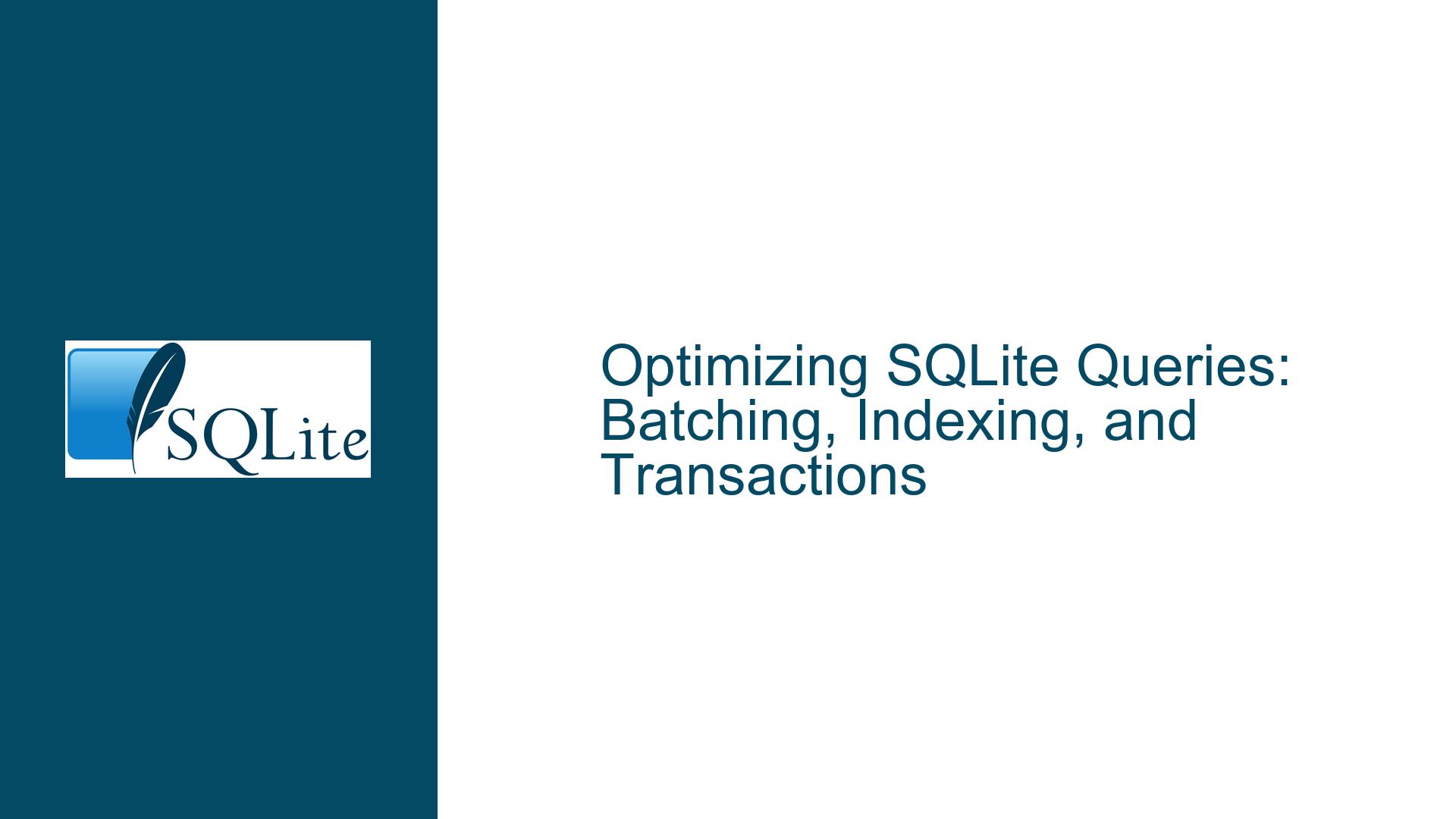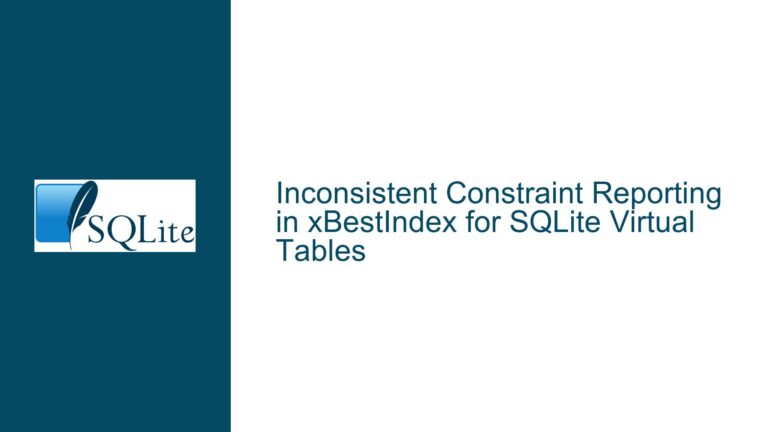Optimizing SQLite Queries: Batching, Indexing, and Transactions
Common Performance Bottlenecks in SQLite Query Execution
SQLite’s lightweight architecture and serverless design make it ideal for embedded systems and low-concurrency applications, but improper query design can lead to significant performance degradation. The most frequent issues stem from inefficient data retrieval patterns, suboptimal indexing strategies, and failure to leverage SQLite’s transaction model. For example, repeated single-row INSERT operations without batching force the database to update its internal structures (e.g., B-tree pages) redundantly, causing excessive disk I/O. Similarly, SELECT queries that scan entire tables due to missing or misconfigured indexes amplify latency, especially in tables with millions of rows.
Range-based queries (e.g., IP range lookups) often suffer when developers rely on naïve BETWEEN clauses without considering how SQLite’s query planner utilizes composite indexes. The optimizer may prioritize an index on the start of the range but fail to account for overlapping intervals, leading to full table scans. Another overlooked issue involves using SELECT * in scenarios where only specific columns are needed. This forces SQLite to fetch entire rows from disk, consuming memory and bandwidth unnecessarily.
Transactions are another critical area. While most developers know to wrap bulk INSERT operations in transactions to avoid per-statement disk synchronization, fewer realize that even read-heavy workloads benefit from explicit transactions. Without them, SQLite may implicitly open and close transactions for each query, adding overhead from journal file updates and filesystem synchronization.
Key Factors Impacting Query Efficiency in SQLite
1. Index Design and Usage
Indexes accelerate data retrieval but impose trade-offs. A table with an integer primary key (IPK) leverages SQLite’s rowid optimization, where the primary key column aliases the built-in rowid for O(1) lookups. However, secondary indexes on non-IPK columns require separate B-tree structures. Each INSERT or UPDATE operation on an indexed column triggers index updates, which explains why bulk inserts into indexed tables are slower. Dropping indexes before bulk inserts and recreating them afterward is a common optimization, but this approach is counterproductive for IPK-based tables due to the inherent efficiency of rowid management.
Composite indexes are underutilized in range queries. For IP range lookups, an index on range_start allows the query planner to quickly locate candidate rows using range_start <= ?, but a separate index on range_end is redundant. Instead, filtering the initial candidates with ? <= range_end in a subquery avoids full table scans.
2. Query Batching and Parameter Binding
Repeated parameterized queries with varying values incur parsing and planning overhead. SQLite’s sqlite3_prepare_v2() compiles queries into bytecode, which can be reused for batched operations. For example, inserting 100 rows via a single INSERT INTO ... VALUES (?, ?), (?, ?), ... statement reduces recompilation cycles and VFS (Virtual File System) calls. Similarly, batched SELECT queries using common table expressions (CTEs) with VALUES clauses allow the optimizer to process multiple parameters in one pass.
3. Transaction Management
Implicit transactions per statement introduce filesystem synchronization latency. Wrapping multiple INSERT/UPDATE/DELETE operations in an explicit BEGIN TRANSACTION…COMMIT block minimizes journal flushes. For read-only workloads, transactions prevent schema changes during multi-statement operations, avoiding SQLITE_BUSY errors.
Advanced Optimization Techniques and Practical Solutions
1. Batched Inserts and Parameterized CTEs
Problem: Inserting 10,000 rows individually takes minutes due to index updates and disk I/O.
Solution: Use multi-row VALUES clauses. SQLite supports up to 999 parameters per statement, but testing shows diminishing returns beyond 100 rows due to memory pressure. Example:
INSERT INTO sensor_data (timestamp, value)
VALUES (?, ?), (?, ?), ..., (?, ?);
For selects, leverage CTEs:
WITH params(id) AS (VALUES (1), (2), (3))
SELECT t.* FROM params p
JOIN transactions t ON t.customer_id = p.id;
2. Range Query Optimization
Problem: WHERE ? BETWEEN range_start AND range_end performs poorly with overlapping ranges.
Solution: Use a subquery to limit candidates:
SELECT * FROM (
SELECT * FROM ip_ranges
WHERE range_start <= ?
ORDER BY range_start DESC
LIMIT 10 -- Adjust based on max expected overlaps
) WHERE ? <= range_end;
This leverages the range_start index and reduces comparisons.
3. Integer Primary Keys and Bulk Operations
Problem: Bulk inserts into indexed tables are slow.
Solution: For IPK tables, avoid dropping indexes. SQLite’s rowid-based inserts are faster than recreating indexes. Example:
-- Faster than dropping/recreating indexes
BEGIN TRANSACTION;
INSERT INTO logs (message) VALUES (?), (?), ...;
COMMIT;
4. Transaction Scope Tuning
Problem: Implicit transactions add overhead.
Solution: Explicitly wrap operations:
BEGIN TRANSACTION;
-- Multiple INSERT/UPDATE/DELETE statements
COMMIT;
For reads:
BEGIN TRANSACTION;
SELECT * FROM large_table WHERE ...;
SELECT * FROM related_table WHERE ...;
COMMIT; -- Releases shared locks
5. Leveraging SQLite Expert
Problem: Identifying missing indexes or suboptimal plans.
Solution: Use the .expert command in the SQLite CLI:
sqlite3 database.db
.expert
SELECT * FROM orders WHERE total > 1000;
This suggests indexes and rewrites queries. Note: Extensions like JSON1 or FTS5 require manual loading before using .expert.
6. Subquery vs. Join Optimization
Problem: Joins on large tables are slow.
Solution: Use correlated subqueries when filtering small subsets:
SELECT name, (SELECT COUNT(*) FROM orders WHERE customer_id = c.id)
FROM customers c
WHERE c.state = 'CA';
This avoids hash joins and reduces intermediate result sets.
By systematically addressing indexing strategies, batching, and transaction boundaries, developers can achieve order-of-magnitude improvements in SQLite performance. Always profile queries using EXPLAIN QUERY PLAN and test batch sizes empirically, as hardware and dataset characteristics influence optimal parameters.






